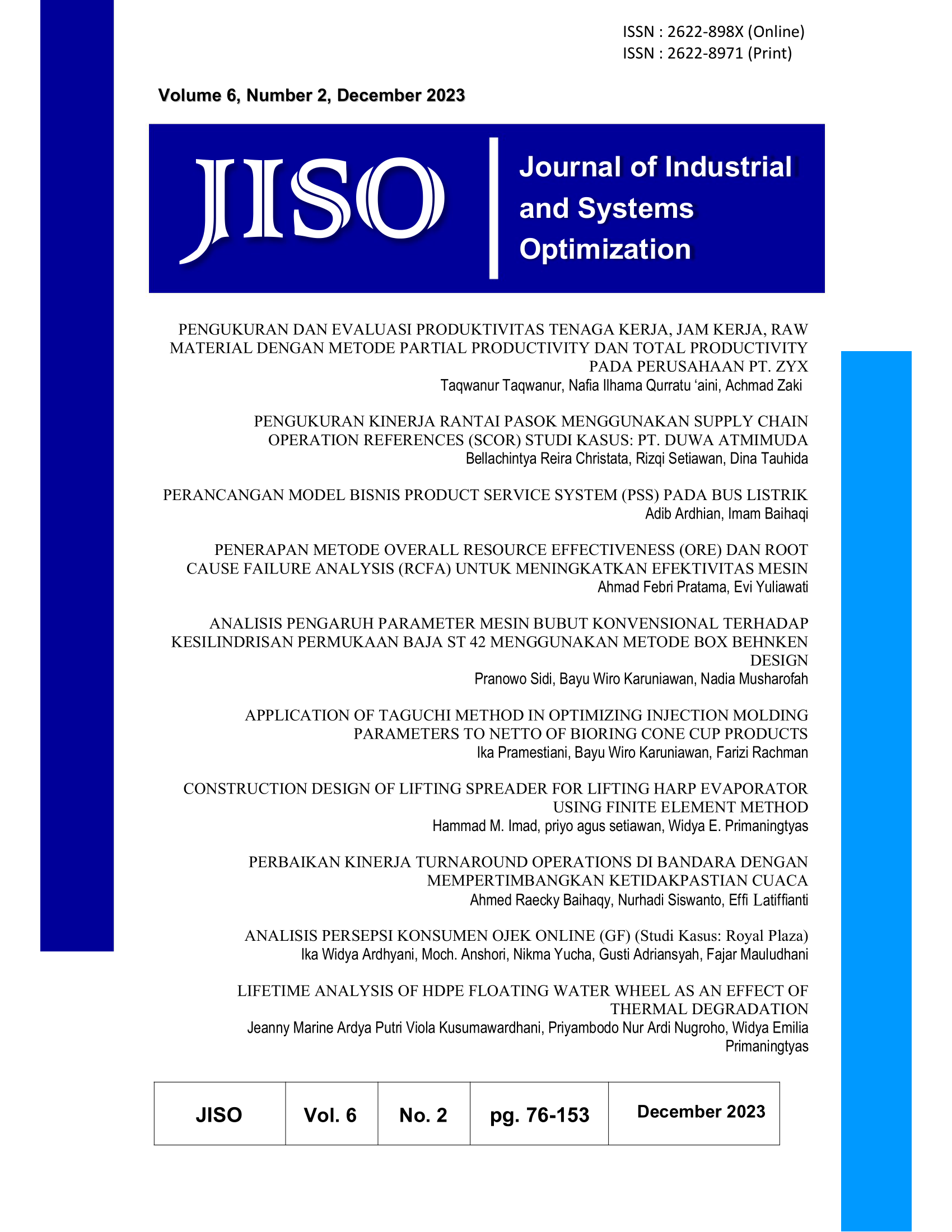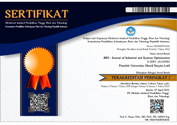ANALISIS PENGARUH PARAMETER MESIN BUBUT KONVENSIONAL TERHADAP KESILINDRISAN PERMUKAAN BAJA ST 42 MENGGUNAKAN METODE BOX BEHNKEN DESIGN
DOI:
https://doi.org/10.51804/jiso.v6i2.110-116Keywords:
Lathe Machine, ST 42 steel, Surface Cylindricity, Box-Behnken DesignAbstract
The dimensional accuracy of the workpiece might be impacted by geometric variations that machines frequently experience. The geometric shape of the workpiece as a result of the machining process can be used to quantify machine quality and can take the form of cylindricality, smoothness, roundness, and other geometric shapes. The results of the workpiece surface's cylindricality will depend on machining parameters such spindel speed, feeding, and depth of cut. For the design of the research experiment and the data analysis, this study employs the Box Behnken Design in Response Surface Method that is figuring out the trial variation using 3 stages. The specimen used was ST 42 steel, and a DNMG 150404 carbide insert tool was used on a Pinacho L-1/260 conventional lathe machine to perform a total of 15 experimental modifications on the specimen. Furthermore, the cylindricity test was carried out using a dial indicator. The research results on the effect of parameters on surface cylindricity, namely engine speed with a Pvalue of 0.068, depth of feed with a Pvalue of 0.784, and feed speed with a Pvalue of 0.839, the three parameters were declared not to have a significant effect. The engine rotation parameter provides a contribution effect of 26.87%, the depth of cut is 0.52% and the feed speed is 0.28%.
Keakuratan dimensi benda kerja mungkin dipengaruhi oleh variasi geometris yang sering dialami mesin. Bentuk geometris benda kerja sebagai hasil dari proses pemesinan dapat digunakan untuk mengukur kualitas mesin dan dapat mengambil bentuk silindris, kehalusan, kebulatan, dan bentuk geometris lainnya. Hasil kesilindrisan permukaan benda kerja akan tergantung pada parameter pemesinan seperti putaran mesin, kecepatan pemakanan, dan kedalaman pemakanan. Untuk desain percobaan penelitian dan analisis data, penelitian ini menggunakan Metode Response Surface Box Behnken Design yaitu mencari tahu variasi percobaan dengan menggunakan 3 tahap. Spesimen yang digunakan adalah baja ST 42, dan alat insert DNMG 150404 carbide digunakan pada mesin bubut konvensional Pinacho L-1/260 untuk melakukan total 15 modifikasi eksperimental pada spesimen. Selanjutnya dilakukan uji kesilindrisan dengan menggunakan dial indikator. Hasil penelitian tentang pengaruh parameter terhadap kesilindrisan permukaan yaitu putaran mesin dengan Pvalue 0,068, kedalaman pemakanan dengan Pvalue 0,784, dan kecepatan pemakanan dengan Pvalue 0,839, ketiga parameter tersebut dinyatakan tidak berpengaruh signifikan. Parameter putaran mesin memberikan efek kontribusi 26,87%, kedalaman umpan 0,52% dan kecepatan umpan 0,28%.
References
Abdullah, Y. U., & Oke, S.A., (2022), Optimizing The Machining Process of IS 2062 E250 Steel Plates with The Boring Operation Using a Hybrid Taguchi-Pareto Box Behnken-teaching Learning-based Algorithm. International Journal of Industrial Engineering and Engineering Management (IJIEEM), Vol. 4 No. 2 page 48 – 64
Ardinta, S. D., Triyono, J., & Muhayat, N. (2011). Pengaruh Gerak Makan dan Sudut Potong Utama Terhadap Hasil Kesilindrisan Permukaan Benda Kerja ST 42 pada Proses Bubut Silindris. Skripsi, Universitas Sebelas Maret, Surakarta.
Ariyanto, Husman, (2018), Pengukuran Keslindrisan Hasil Proses Pemotongan Mesin Bubut Untuk Mengetahui Kemampuan Mesin Menghasilkan Produk. Jurnal Manutech, Vol. 10 No. 02 page 9-13
Aswin, F., Masdani, Randa, & Yulianto, O. (2017). Rekondisi Mesin Bubut DoALL LT 13 BU01DI Laboratorium Mekanik Politeknik Manufaktur Negeri Bangka Belitung. Jurnal Manutceh, Vol. 9 No. 1 , page 24-32
Boothroyd, Geoffrey., Winston A. Knight, (1975), Fundamentals of Machining and Machine Tools, Second Edition, Marcel Dekker, Inc. New York-Basel.
Duran, A., & Nalbant, M. (2005). Finite Element Analysis of Bending Occurring Whilecutting with High Speed Steel Lathe Cutting Tools. Materials & Design, Volume 26, Issue 6, page 549-554.
Harianto, D. (2017). Rancang Bangun Alat Pengukur Kesilindrisan Dengan Metode 3 Poin. Prosiding Seminar Nasional Teknologi Industri V. Politeknik ATI Makassar, Makassar
Montgomery, D. C. (2013). Design and Analysis of Experiments. John Wiley & Sonc, Inc. Singapore.
Nazihah, Shaharudin (2009), Cylindricity of workpiece in conventional lathe machine, Project Papers. Universiti Malaysia Pahang, Faculty of Mechanical Engineering
Nugroho, Adi, (2009), Pengaruh Gerak Makan dan Sudut Potong Utama Terhadap Hasil Kesilindrisan Permukaan Benda Kerja pada Proses Bubut Silindris, Skripsi, Universitas Sebelas Maret, Surakarta
Petropoulos, G., Kechagias, J., & Lakovakis, V. (2009). Surface Roughness Investigation of a Reinforced. International Conference on Economic Engineering and Manufacturing Systems, 381-384
Putra, R.C., (2016), Studi Eksperimental Pengujian Kekasaran Permukaan dan Keaurasian Dimensi pada Proses Dry Machining Baja AISI 01, Jurnal Teknik, Vol. 5, No.1 hal 17-24. ISSN: 2302-8794
Rochim, Taufiq, (2001), Spesifikasi, Metrologi, dan Kontrol Kualitas Geometrik 1, ITB, Bandung
Rochim, Taufiq, (1993), Teori dan Tekonologi Permesinan, Institut Teknologi Bandung, Bandung.
Wirawan Sumbodo, dkk. (2008), Teknik Produk Mesin Industri Jilid 1. Jakarta, Departemen Pendidikan Nasional.
Downloads
Published
Issue
Section
License
Copyright (c) 2023 JISO : Journal of Industrial and Systems Optimization

This work is licensed under a Creative Commons Attribution-ShareAlike 4.0 International License.
With the receipt of the article by JISO Editorial Board and the decision to be published, the copyright regarding the article will be transferred to JISO. The copyright transfer form can be downloaded here.
JISO has the right to multiply and distribute the article and every author is not allowed to publish the same article that was published in this journal.
JISO is licensed under a Creative Commons Attribution-ShareAlike 4.0 International License.
Under the following terms:
Attribution — You must give appropriate credit, provide a link to the license, and indicate if changes were made. You may do so in any reasonable manner, but not in any way that suggests the licensor endorses you or your use.
ShareAlike — If you remix, transform, or build upon the material, you must distribute your contributions under the same license as the original.














